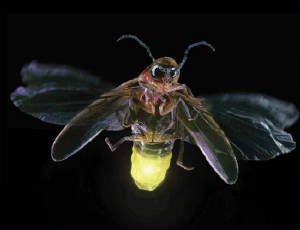 There are many great articles on the web about lightning bugs or fireflies. They are really beetles - I remember a National Geographic article titled "Planet of the Beetles,"
because of the some half a million different species of beetles on the planet - that spells Special Creation right there! If you check out some of the articles I list below, note the extreme complexity of this whole
thing, some 2000 different species of these fireflies or lightning bugs, and all with unique light patterns and habits, and
their amazing luminescence with each minute aspect of this thing encoded in their DNA. I was
sickened at a "Bible Church" doctrinal statement I read concerning the "existence of God" - it said: "The Bible simply ASSUMES the EXISTENSE of GOD!" It then added a few bible verses as proof. This is a lie -- in fact it is out-right blasphemy. It trashes all the mighty works God did in his Special
Creation. The Bible lists numerous wondrous things God has made and done, which only that
Almighty, Immortal being could possible do -- proving absolutely, God's existence. Hardly an assumption! Fire flies are another
stunning example of the incredible handiwork of God, which we see everywhere we look. The bioluminescence
of these organisms is detailed by the Answers In Genesis and Wikipedia articles below, and elsewhere, and shows Gods awesome
engineering. Carol has a neat blog, Fireflies: Bright Lights in June where she reminisces in the delight she finds in the first annual appearance of these creatures,
and the special wonder children always find in lightning bugs. National Geographic has a short concise article on Fire Flies, with a beautiful picture, of course. I get a kick
out of the scientific name for the family, -- Lampyridae -- obviously like a "lamp." One of the chemicals in this beetle that is used to make the luminescence is luciferin. This reminds us of Lucifer ("light bearer" and "Son of the Morning"), the fallen angel who became
the Devil and Satan. This is not the fault of these little luminescent
beetles, of course. A great article from Creationist - Answers in Genesis - is
- Lightning Bugs: The Beetle Beacons: Note: This article is well worth reading in its entirety. Note:
Beneath the chemistry, seemly made-simple explanation, is an awesome amount of extreme complexity. The article says: "The most amazing thing about lightning bugs, of course,
is their ability to produce light (bioluminescence), which they switch on and off at will. So what mechanism performs this
magic? The last two or three segments of the abdomen make up the glow organ. Here, underneath the exoskeleton, are specialized
cells called photocytes (light cells). These light cells need several ingredients to make light. One is a chemical
called luciferin (remember Lucifer, who was the “angel of light”). A second ingredient, called luciferase, causes
the luciferin to break down and produce light. A third ingredient is the common molecule ATP (adenosine triphosphate), which
provides the energy to drive the chemical reaction. These ingredients are always present in a glow organ. So why isn’t
it constantly glowing? How does the firefly turn off its light? The last ingredient is oxygen. The chemical reaction can’t
take place without oxygen. No oxygen; no reaction; no light. One widely held theory of how the firefly turns its light
off is that it simply shuts off the oxygen supply (oxygen control theory). Whenever the insect needs the light to glow again,
it feeds oxygen to the glow organ, and—voilá—the reaction begins again. Another amazing feature
is that the light cells are just beneath a transparent exoskeleton so that the light can freely shine from the abdomen.
No sense in hiding your light under a bushel." 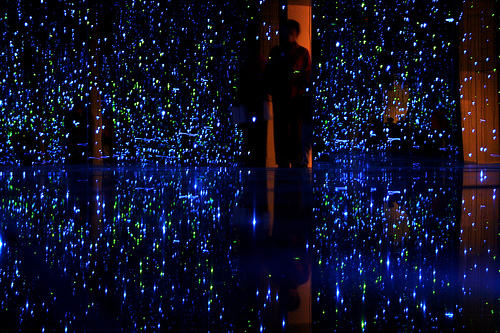 |
 |
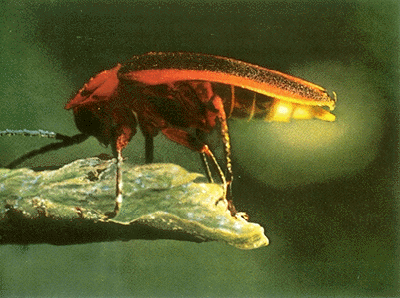 Wikipedia has an extensive article -- well worth reading -- I include part of it below: "Lampyridae
is a family of insects in the beetle order Coleoptera. They are winged beetles, and commonly called fireflies
or lightning bugsfor their conspicuous crepuscular use of bioluminescence to attract mates or prey. Fireflies
produce a "cold light", with no infrared or ultraviolet frequencies. This chemically-produced light from the lower
abdomen may be yellow, green, or pale-red, with wavelengths from 510 to 670 nanometers. About 2,000 species of firefly are found in temperate and tropical environments. Many are in marshes or in wet,
wooded areas where their larvae have abundant sources of food. These larvae emit light and are often called "glowworms",
in particular, in Eurasia. In the Americas, "glow worm" also refers to the related Phengodidae. In many species,
both male and female fireflies have the ability to fly, but in some species, females are flightless. Fireflies, also
known as glow worms, tend to be brown and soft-bodied, often with the elytra more leathery than in other beetles. Though the
females of some species are similar in appearance to males, larviform females are found in many other firefly species. These
females can often be distinguished from the larvae only because they have compound eyes. The most commonly known fireflies
are nocturnal, though there are numerous species that are diurnal. Most diurnal species are nonluminescent, though some species
that remain in shadowy areas can produce light. Light production in fireflies is due to a type of chemical reaction
called bioluminescence. This process occurs in specialised light-emitting organs, usually on a firefly's lower abdomen. The
enzyme luciferase acts on the luciferin, in the presence of magnesium ions, ATP, and oxygen to produce light. Genes coding
for these substances have been inserted into many different organisms (see Luciferase – Applications). Firefly
luciferase is used in forensics, and the enzyme has medical uses — in particular, for detecting the presence of ATP
or magnesium. It has been speculated that Baroque painter Caravaggio may have prepared his canvases with a powder of dried
fireflies to create a photosensitive surface on which he projected the image to be painted. All fireflies glow as larvae.
Bioluminescence serves a different function in lampyrid larvae than it does in adults. It appears to be a warning signal to
predators, since many firefly larvae contain chemicals that are distasteful or toxic. Light in adult beetles was originally
thought to used for similar warning purposes, but its primary purpose is now thought to be used in mate selection. Fireflies
are a classic example of an organism that uses bioluminescence for sexual selection. They have a variety of ways to communicate
with mates in courtships: steady glows, flashing, and the use of chemical signals unrelated to photic systems. Some
species, especially lightning bugs of the genera Photinus, Photuris, and Pyractomena, are distinguished
by the unique courtship flash patterns emitted by flying males in search of females. In general, females of the Photinusgenus
do not fly, but do give a flash response to males of their own species. Tropical fireflies, in particular, in Southeast
Asia, routinely synchronise their flashes among large groups. This phenomenon is explained as phase synchronization and spontaneous
order. At night along river banks in the Malaysian jungles (the most notable ones found near Kuala Selangor), fireflies (kelip-kelipin
the Malay language or Bahasa Malaysia) synchronise their light emissions precisely. Current hypotheses about the causes of
this behavior involve diet, social interaction, and altitude. In the Philippines, thousands of fireflies can be seen
all year-round in the town of Donsol (called aninipot or totonbalagonin Bicol). In the United States, one
of the most famous sightings of fireflies blinking in unison occurs annually near Elkmont, Tennessee in the Great Smoky Mountains
during the first weeks of June. Congaree National Park in South Carolina is another host to this phenomenon. Female
Photuris fireflies are known for mimicking the mating flashes of other "lightning bugs" for the sole purpose
of predation. Target males are attracted to what appears to be a suitable mate, and are then eaten. For this reason the Photuris
species are sometimes referred to as "femme fatale fireflies." Many fireflies do not produce light.
Usually these species are diurnal, or day-flying, such as those in the genus Ellychnia. A few diurnal fireflies that
inhabit primarily shadowy places, such as beneath tall plants or trees, are luminescent. One such genus is Lucidota.
These fireflies use pheromones to signal mates. This is supported by the fact that some basal groups do not show bioluminescence
and, rather, use chemical signaling. Phosphaenus hemipterushas photic organs, yet is a diurnal firefly and
displays large antennae and small eyes. These traits strongly suggests pheromones are used for sexual selection, while photic
organs are used for warning signals. In controlled experiments, males coming from downwind arrived at females first, thus
male arrival was correlated with wind direction, indicating males' chemotaxis into a pheromone plume. Males were also found
to be able to find females without the use of visual cues, when the sides of test Petri dishes were covered with black tape.
This and the facts that females do not light up at night and males are diurnal point to the conclusion that sexual communication
in P. hemipterus is entirely based on pheromones." 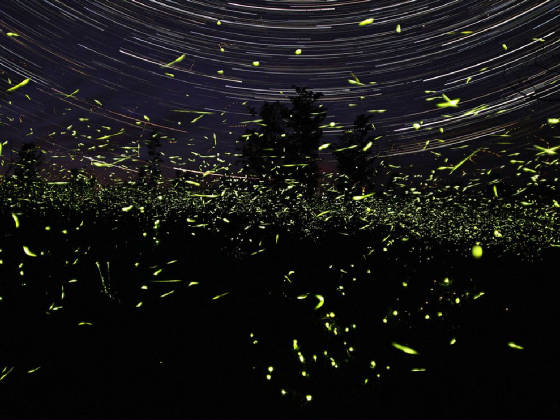 |
 |
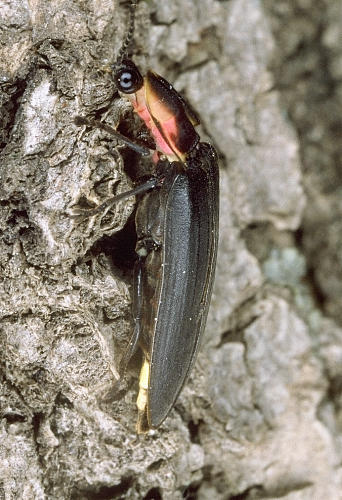 Wikipedia on the biology of fireflies: Fireflies, also known as glow worms, tend to be brown and soft-bodied,
often with the elytra more leathery than in other beetles. Though the females of some species are similar in appearance to
males, larviform females are found in many other firefly species. These females can often be distinguished from the larvae
only because they have compound eyes. The most commonly known fireflies are nocturnal, though
there are numerous species that are diurnal. Most diurnal species are nonluminescent, though some species that remain in shadowy
areas can produce light. A few days after mating, a female lays her fertilized eggs on or just
below the surface of the ground. The eggs hatch three to four weeks later, and the larvae feed until the end of the summer.
The larvae are commonly called glowworms, not to be confused with the distinct beetle family Phengodidae or fly genus Arachnocampa.
Lampyrid larvae have simple eyes. The term glowworm is also used for both adults and larvae of
species such as Lampyris noctiluca, the common European glowworm, in which only the nonflying adult females glow
brightly and the flying males glow only weakly and intermittently. Fireflies hibernate over winter
during the larval stage, some species for several years. Some do this by burrowing underground, while others find places on
or under the bark of trees. They emerge in the spring. After several weeks of feeding, they pupate for 1.0 to 2.5 weeks and
emerge as adults. The larvae of most species are specialized predators and feed on other larvae, terrestrial snails, and slugs.
One such species is Alecton discoidalis, which is found in Cuba. Some are so specialized,
they have grooved mandibles that deliver digestive fluids directly to their prey. Adult diet varies. Some are predatory, while
others feed on plant pollen or nectar. Most fireflies are quite distasteful and sometimes poisonous
to vertebrate predators. This is due at least in part to a group of steroid pyrones known as lucibufagins (LBGs), which are
similar to cardiotonic bufadienolides found in some poisonous toads.
 |
 |
 Psalm
103: 1 Bless the Lord, O my soul: and all that is within me, bless his holy name. 2 Bless the Lord, O my soul, and forget not all his benefits: 3 Who forgiveth all thine iniquities; who healeth all thy diseases; 4 Who redeemeth thy life from destruction; who crowneth
thee with lovingkindness and tender mercies; 5 Who
satisfieth thy mouth with good things; so that thy youth is renewed like the eagle's. 6 The Lord
executeth righteousness and judgment for all that are oppressed. 7 He made known his ways unto Moses, his acts unto the children of Israel. 8 The Lord
is merciful and gracious, slow to anger, and plenteous in mercy. 9 He will not always chide: neither will he keep his anger for ever. 10 He hath not dealt with us after our sins; nor rewarded
us according to our iniquities. 11 For
as the heaven is high above the earth, so great is his mercy toward them that fear him. 12 As far as the east is from the west, so far hath he removed our
transgressions from us. 13 Like
as a father pitieth his children, so the Lord pitieth them
that fear him. 14 For
he knoweth our frame; he remembereth that we are dust. 15 As for man, his days are as grass: as a flower of the field, so he flourisheth. 16 For the wind passeth over it, and it is gone; and the
place thereof shall know it no more. 17 But
the mercy of the Lord is from everlasting to everlasting
upon them that fear him, and his righteousness unto children's children; 18 To such as keep his covenant, and to those that remember his commandments to do them. 19 The Lord
hath prepared his throne in the heavens; and his kingdom ruleth over all. 20 Bless the Lord, ye his angels,
that excel in strength, that do his commandments, hearkening unto the voice of his word. 21 Bless ye the Lord, all ye his hosts; ye ministers of his, that do his pleasure. 22 Bless the Lord,
all his works in all places of his dominion: bless the Lord,
O my soul.
Psalm
104: 1 Bless
the Lord, O my soul. O Lord my God, thou art very great; thou art clothed with honour and majesty. 2 Who coverest thyself with light as with a garment: who stretchest out the
heavens like a curtain: 3 Who layeth the
beams of his chambers in the waters: who maketh the clouds his chariot: who walketh upon the wings of the wind: 4 Who maketh his angels spirits; his ministers a flaming fire: 5 Who laid the foundations of the earth, that it should not be
removed for ever. 6 Thou coveredst it with
the deep as with a garment: the waters stood above the mountains. 7 At
thy rebuke they fled; at the voice of thy thunder they hasted away. 8 They go up by the mountains; they go down by the valleys unto the place which thou hast founded
for them. 9 Thou hast set a bound that
they may not pass over; that they turn not again to cover the earth. 10 He sendeth the springs into the valleys, which run among the hills. 11 They give drink to every beast of the field: the wild asses
quench their thirst. 12 By them shall
the fowls of the heaven have their habitation, which sing among the branches. 13 He watereth the hills from his chambers: the earth is satisfied with the fruit of thy works. 14 He causeth the grass to grow for the cattle, and herb for the
service of man: that he may bring forth food out of the earth; 15 And
wine that maketh glad the heart of man, and oil to make his face to shine, and bread which strengtheneth man's heart. 16 The trees of the Lord are full of sap; the cedars of Lebanon, which he hath planted; 17 Where the birds make their nests: as for the stork, the fir trees are her
house. 18 The high hills are a refuge
for the wild goats; and the rocks for the conies. 19 He
appointed the moon for seasons: the sun knoweth his going down. 20 Thou
makest darkness, and it is night: wherein all the beasts of the forest do creep forth. 21 The young lions roar after their prey, and seek their meat from God. 22 The sun ariseth, they gather themselves together, and lay them
down in their dens. 23 Man goeth forth
unto his work and to his labour until the evening. 24 O
Lord, how manifold are thy works! in wisdom hast thou made
them all: the earth is full of thy riches. 25 So
is this great and wide sea, wherein are things creeping innumerable, both small and great beasts. 26 There go the ships: there is that leviathan, whom thou hast
made to play therein. 27 These wait all
upon thee; that thou mayest give them their meat in due season. 28 That
thou givest them they gather: thou openest thine hand, they are filled with good. 29 Thou hidest thy face, they are troubled: thou takest away their breath, they die, and return
to their dust. 30 Thou sendest forth thy
spirit, they are created: and thou renewest the face of the earth. 31 The glory of the Lord shall
endure for ever: the Lord shall rejoice in his works. 32 He looketh on the earth, and it trembleth: he toucheth the
hills, and they smoke. 33 I will sing
unto the Lord as long as I live: I will sing praise to my
God while I have my being. 34 My meditation
of him shall be sweet: I will be glad in the Lord. 35 Let the sinners be consumed out of the earth, and let the wicked
be no more. Bless thou the Lord, O my soul. Praise ye the
Lord.  |
|

